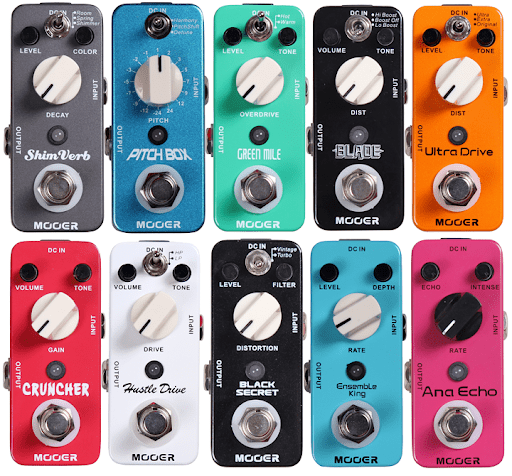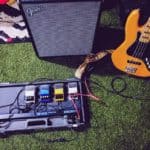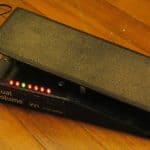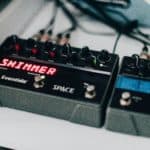When looking for affordable pedals to add to your palette, Mooer is a brand that usually pops up very frequently.
These pedals come in great variety and at very accessible prices.
Whatever kind of effect you look for, probably Mooer has you covered.
But are mooer pedals any good? Here is the short answer:
Mooer pedals would surely not let you down and do their job fine. They come in a great variety of models and you could find within their range just about anything to shape your dream tone. The catch when opting for affordable gear is that you won’t get any unique or custom tones. These are generic pedals.
For those who want to dive deeper, in this article, I will try to answer the most common questions about this brand of pedals.
After reading this post you will have a clearer idea about what to expect from this very popular manufacturer.
Are you ready to get started?
Let’s go!
How good are Mooer pedals quality-wise?
Mooer pedals are affordable guitar pedals that do their job without any fancy add-on. Their build quality is pretty good, but just as about any other kind of import pedal. The bar has lifted noticeably lately. In terms of audio, these effects will deliver tones 70% to 90% similar to their inspiring gear.
Do Mooer pedals sound good?
Mooer pedals do sound good and they will deliver nice usable tones on a budget. The main differences with more boutique pedals are uniqueness and tone customizability. Most Mooer pedals are designed to be pretty generic approaches to the effects they produce. For unique flavors, you will have to pay extra.
I, personally own a few of these and I’m very happy with them. The Ensemble King and the Ninety Orange are just two amazing additions to my board. These are effects that don’t define my tone, and I just drop here and there as a bit of spice.
If I were to need more specific instances of chorus or phaser I would probably go look for something more boutique, unique or customizable. But for now, I’m just fine.
Are Mooer pedals true bypass?
Most Mooer pedals I could think of are true bypass. For more specific answers you should visit the manufacturer’s website and look for the particular specs of the one that interests you. There you will see it clearly stated in the product’s description.
Are Mooer pedals analog?
Mooer manufactures an ample variety of effects pedals. Most of their individual effect lineup is what you would consider analog. However, their multi-effect units are mostly digital and this is the way the company seems to be turning lately since it’s a great way to offer sound variety on a budget.
Where are Mooer pedals made?
Mooer pedals are made in China. The company is based in Shenzhen, China. However, it is likely that they outsource manufacturing to many different factories within China. Some of their models have the same internals that many other Chinese brands or even white label products offered abroad.
This is very common among generic equipment made in China since intellectual property law is almost nonexistent.
Are Mooer, Rowin, and Donner pedals the same?
It is very likely that Mooer, Rowin, and Donner are just rebranded versions of the same white label pedals produced by some factory in China.
However, it is also likely that just any of these brands, or perhaps another came up with the designs, and all the others just copied them.
As I mentioned earlier this is a very common practice within China’s industry since there is little to no enforcement of patent law that prevents companies from just ripping off each other.
Here is some proof of these claims, thanks to the user Nightbreed from the Gear Page forum:
List of most popular Mooer pedals and their tonal inspiration
Most Mooer pedals are inspired by very famous counterparts from other companies. Their business is providing budget alternatives to the real deals.
Here is a list of some of their pedals and the models that most probably inspired them:
| Mooer pedal | Likely clone of |
| Acoustikar | Acoustic Simulator AC-2 |
| Ana Echo | Delay DM-2 |
| Black Secret | Rat |
| Blade | Metal Muff |
| Blue Comp | Compression Sustainer CS-2 |
| Blue Faze | Fuzz Face |
| Blues Crab | Bluesbreaker |
| Blues Mood | Blues Driver BD-2 |
| Cruncher | Crunch Box |
| Echolizer | AD999 |
| Elec Lady (E-lady) | Electric Mistress |
| Ensemble King | Chorus CE-2 |
| Ensemble Queen Bass | Bass Chorus CEB-3 |
| Flex Boost | AC Booster |
| Fog | Woolly Mammoth |
| Funky Monkey | Auto Wah AW-2 |
| Graphic G | Graphic Equalizer GE601 |
| Graphic B | Bass Equalizer GEB-7 |
| Green Mile | Tube Screamer |
| Grey Faze | Fuzz Face |
| Hustle Drive | OCD |
| Micro ABY | Switchblade |
| Ninety Orange | Phase 90 |
| Noise Killer | Decimator |
| Pitch Box | Super Shifter PS-5 |
| Pure Boost | RC Booster |
| Pure Octave | Super Octave OC-3 |
| Rage Machine | Death Metal |
| ReEcho | Digital Delay DD-2 |
| Repeater | Echo Pro/DL4 Delay Modeler |
| Rumble Drive | Zendrive |
| Shim Verb | blueSky |
| Slow Engine | Slow Gear SG-1 |
| Solo | Riot |
| Sweeper | Bassballs |
| Tender Octaver | Micro POG |
| Thunderball Bass | Bass Blogger |
| Trelicopter | Tremulator |
| Triangle Buff | Big Muff Pi (Triangle) |
| Ultra Drive | Distortion DS-1 |
| Yellow Comp | Compressor CPR-1 |
Of course, take this with a grain of salt and let your ear decide how close both are.

Hello there, my name is Ramiro and I’ve been playing guitar for almost 20 years. I’m obsessed with everything gear-related and I thought it might be worth sharing it. From guitars, pedals, amps, and synths to studio gear and production tips, I hope you find what I post here useful, and I’ll try my best to keep it entertaining also.





